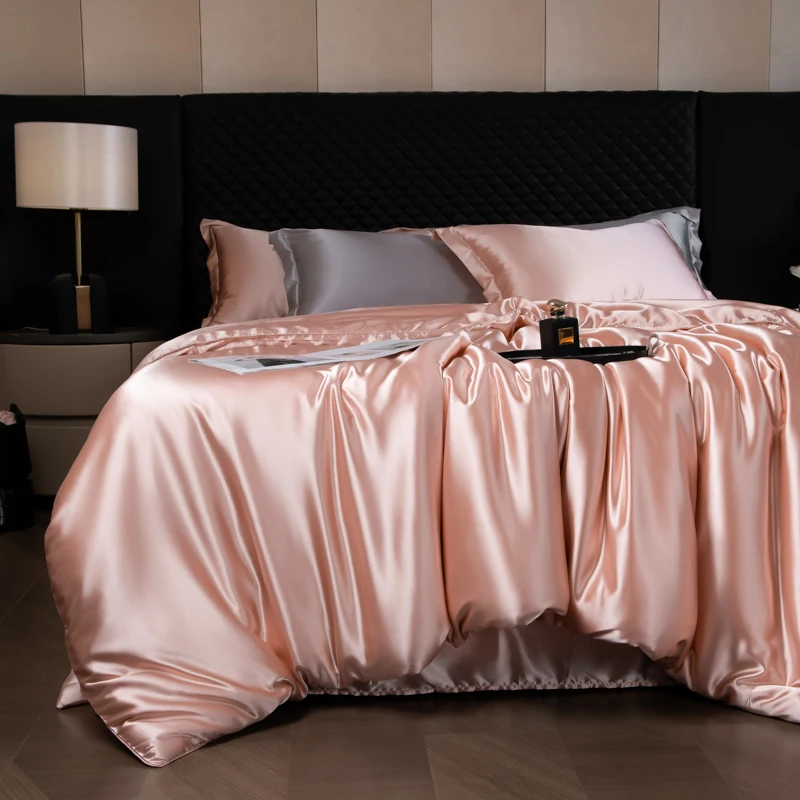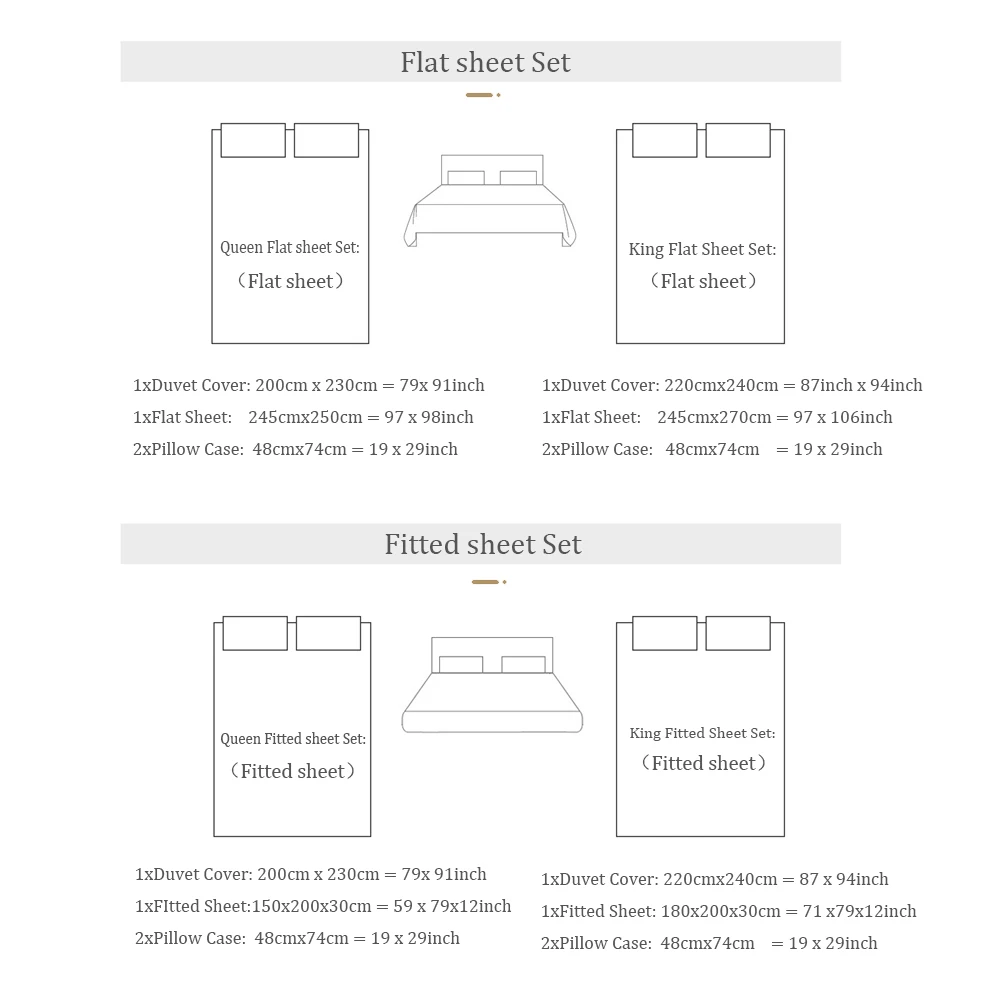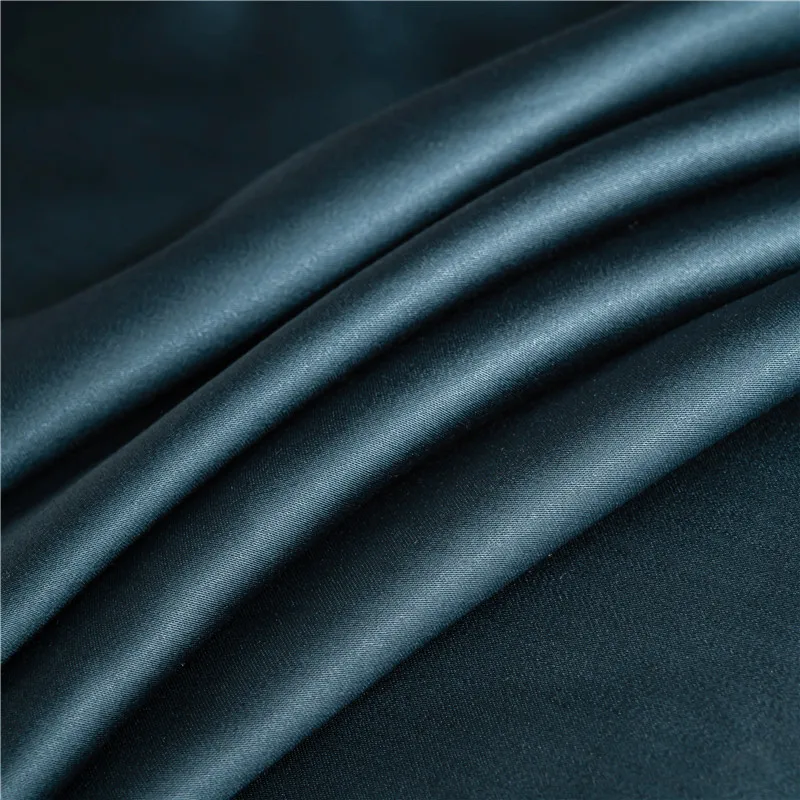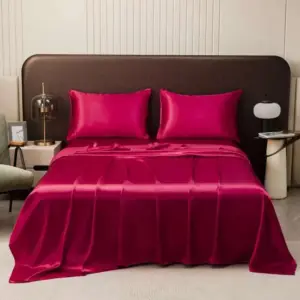Beyond Cotton: What Thread Count Really Means
When shopping for bedding, you’ve likely encountered the term “thread count” countless times. But what exactly does it mean? Thread count is simply the number of threads woven per square inch of fabric, counting both horizontal (weft) and vertical (warp) threads. This measurement gained popularity as the go-to quality indicator for cotton sheets, where higher numbers often (but not always) suggest better quality.
For cotton sheets, thread counts typically range from 200 to 800, with higher counts generally offering a smoother feel and potentially better durability. However, it’s important to understand that thread count was developed specifically for cotton and other staple fiber fabrics.
Thread Count Definition
The total number of horizontal and vertical threads woven into one square inch of fabric. For example, a 300 thread count sheet has 150 vertical threads and 150 horizontal threads per square inch.
Unfortunately, thread count has become somewhat of a marketing gimmick in recent years. Some manufacturers inflate thread count numbers by counting multiple plies within a single thread or using creative counting methods that don’t actually improve quality. You might see claims of 1000+ thread count sheets that don’t actually feel or perform any better than those with lower counts.
This marketing confusion becomes even more problematic when the concept of thread count is misapplied to fabrics where it’s not the primary quality indicator – like silk. Understanding the amazing benefits of mulberry silk sheets requires looking beyond simple thread counts to more appropriate quality metrics.
Before investing in silk bedding, it’s worth familiarizing yourself with the complete guide to mulberry silk bed sheets to understand the unique properties that make this luxury fabric so special.
Why Thread Count Doesn’t Apply to Silk Sheets
When we talk about silk sheets, thread count becomes largely irrelevant due to the fundamental differences between silk and cotton fibers. This distinction is crucial for understanding why silk quality is measured differently.
Cotton consists of short staple fibers typically measuring 1/2 to 2 inches in length. These short fibers must be spun together to create longer threads for weaving. In contrast, silk is composed of continuous filaments that can stretch an astonishing 1,000 to 3,000 feet from a single cocoon. These natural filaments are incredibly fine—approximately one-fifth the diameter of human hair.
This structural difference means that counting threads in silk doesn’t provide meaningful information about quality. The extraordinary length and fineness of silk filaments result in a naturally smooth fabric with fewer thread intersections, regardless of how many threads are counted per inch.
Consider this: the same thread count in cotton and silk would represent completely different fabric structures and qualities. A 300-thread-count cotton sheet uses many short fibers spun together to create each thread, while silk’s long continuous filaments would create an entirely different fabric at the same count.
Additionally, silk’s exceptional qualities—its lustrous sheen, temperature regulation, and hypoallergenic properties—come from the protein structure of the fiber itself, not from how many threads are packed into each inch.
For those seeking truly premium bedding, exploring our selection of mulberry silk sheets can provide insight into how quality silk is properly evaluated and described. To better understand the appropriate measurement systems for silk, our guide comparing momme versus thread count offers valuable clarity.
Momme Weight: The True Measure of Silk Quality
Instead of thread count, the quality and density of silk fabric is measured using “momme weight” (pronounced “moe-mee” and often abbreviated as “mm”). This Japanese-derived standard has become the industry benchmark for evaluating silk quality worldwide.
Momme Weight Definition
The weight in pounds of a piece of silk measuring 45 inches by 100 yards. Alternatively, it can be understood as the weight in grams of a 100cm × 100cm piece of silk fabric.
Momme weight directly indicates the density of silk fibers in the fabric. When silk has a higher momme count, it contains more silk per square inch, resulting in greater durability, a richer feel, and better draping qualities.
Mathematically, one momme equals approximately 4.340 grams per square meter of fabric. This precise measurement emerged from the historical silk trade between Japan and other nations, where standardized measurements were essential for fair commerce.
Professional textile manufacturers measure momme weight under controlled conditions, using precise equipment to weigh standardized sizes of silk fabric. This scientific approach provides a consistent and reliable indicator of silk density and quality—something that simple thread counting cannot achieve for silk fabrics.
The beauty of the momme weight system is that it captures the essence of what makes silk luxurious: the amount of the precious material itself. While thread count simply tells you how many threads exist in a given area, momme weight tells you how substantial and rich the silk fabric actually is.
For those interested in the technical aspects of silk measurement, our detailed guide on weight conversion for silk momme provides additional insights into this specialized measurement system.
Decoding Momme: What to Look for in Silk Sheets
Understanding momme weight helps you make informed decisions when purchasing silk sheets. Different momme weights create distinctly different fabrics, each with unique properties and best uses:
| Momme Range | Characteristics | Best Uses | Price Point |
|---|---|---|---|
| 11-13 momme | Lightweight, slightly transparent, delicate | Summer clothing, scarves, lingerie | Lower |
| 16-19 momme | Medium weight, good balance of durability and softness | Quality bedding, versatile apparel | Moderate |
| 19-25 momme | Luxury weight, optimal for bedding, substantial feel | Premium bedding, luxurious sleepwear | Higher |
| 22-30 momme | Heavy weight, extremely durable, rich draping | Highest quality bedding, heirloom pieces | Premium |
For bedding specifically, the 19-25 momme range represents the sweet spot that combines luxury, durability, and value. Sheets in this range offer:
- Substantial feel without being too heavy
- Excellent durability for regular use
- Rich, luminous appearance
- Natural temperature regulation
- Ideal draping qualities that conform to the body

Lower momme silk (11-13) may feel nice initially but typically won’t stand up to regular use as bedding. These lighter fabrics may show wear more quickly and can be too delicate for nightly use. Conversely, very high momme weights (above 25) offer exceptional durability but come with a significantly higher price point and may feel too heavy for some sleepers.
The difference between 19 momme and 25 momme sheets is noticeably apparent when you handle them side by side. The 25 momme sheets feel more substantial and luxurious, while 19 momme sheets offer a lighter feel while still maintaining durability for regular use.
Exploring our collection of 100% silk sheets allows you to compare different momme weights and find the perfect balance for your preferences and budget.
Momme vs. Thread Count: A Direct Comparison
To clarify how these two measurement systems differ, let’s compare momme weight and thread count side by side:
| Quality Factor | Momme Weight | Thread Count |
|---|---|---|
| Primary use for | Silk fabrics | Cotton and staple fiber fabrics |
| What it measures | Fabric density by weight | Number of threads per square inch |
| Relation to durability | Direct correlation – higher momme = more durable | Variable correlation in cotton; not applicable to silk |
| Range for quality bedding | 19-25 momme for premium silk | 300-600 for quality cotton |
| Marketing reliability | Generally truthful and standardized | Often inflated or misrepresented |
| Price indicator | Reliable indicator of material quantity | Unreliable for silk; variable for cotton |
When shopping for silk sheets, you may occasionally see products marketed with both measurements. This can be confusing and potentially misleading. Here’s what to understand:
If silk sheets are advertised with thread count as the primary quality indicator, this suggests the seller may be using cotton-based marketing language for silk products. While some manufacturers may provide thread count figures (typically ranging from 300-600 for silk), this number is far less meaningful than the momme weight.
Some marketers attempt to capitalize on consumer familiarity with thread count by emphasizing this metric over momme weight. Always prioritize the momme weight when evaluating silk sheet quality, as it provides a much more accurate indication of what you’re actually buying.
For a comprehensive selection of silk bedding options with clearly indicated momme weights, browse our silk sheets collection to see the difference proper quality metrics make.
Beyond Weight: Other Essential Quality Factors for Silk Sheets
While momme weight is the primary quality indicator, several other factors significantly impact silk sheet quality:
Type of Silk
Mulberry Silk is the gold standard for bedding. Produced by Bombyx mori silkworms fed exclusively on mulberry leaves, this silk contains high protein content (around 18 amino acids) and creates exceptionally smooth, consistent filaments. Mulberry silk accounts for over 90% of the world’s silk production and offers the best combination of durability and luxury for bedding.
Other silk types like Tussar, Eri, or Wild silk have more textured surfaces and irregularities that make them less suitable for premium bedding.
Silk Grade
Silk is graded on an A-system, with 6A representing the highest quality:
– 6A: Top-tier silk with the most consistent filaments and fewest imperfections
– 5A: Excellent quality with minimal imperfections
– 4A: Good quality with some minor irregularities
– 3A and below: Lower grades with more inconsistencies
Weave Type
Charmeuse is the classic silk sheet weave, featuring a satin weave on one side and a matte finish on the reverse. This creates the iconic lustrous appearance and smooth feel associated with luxury silk bedding.
Other common weaves include:
– Habotai: Lighter, less expensive, but less durable
– Silk Satin: Very smooth and shiny but may be less breathable
– Silk Twill: More durable with a subtle diagonal pattern

Certifications
Look for reputable certifications that verify quality and safety:
– OEKO-TEX Standard 100: Ensures the fabric is free from harmful substances
– BSCI Compliance: Verifies ethical production standards
– ISO Certifications: Indicates adherence to international quality standards
Construction Details
Quality silk sheets feature:
– French seams or flat-felled seams for durability
– Generous hem depths (at least 1-2 inches)
– Even stitching with appropriate thread count for the fabric weight
– Careful color matching and consistent dyeing
– Envelope closures on pillowcases to secure pillows
Understanding what makes mulberry silk special can help you appreciate the unique properties this premium material brings to your bedding. Additionally, learning why silk bedding quality and momme weight matters provides deeper insight into how these various factors work together.
How to Identify High-Quality Silk Sheets
When shopping for silk sheets, use these practical techniques to assess quality:
Touch Test
Quality silk feels smooth and cool to the touch, but not slippery or synthetic. It should have a subtle weight that feels substantial without being heavy. Run your hand across the fabric—premium silk creates a soft, gentle resistance rather than a slick or sticky sensation.
Visual Inspection
- Even color: Look for consistent coloration throughout
- Subtle luster: High-quality silk has a soft, luminous sheen rather than a plastic-like shine
- Tight, even weave: Hold up to light to check for consistency
- Smooth surface: Free from slubs, knots, or irregularities (unless it’s wild silk, which naturally has these)
Product Specifications Checklist:
- ✓ Momme weight clearly stated (19-25mm ideal for bedding)
- ✓ Mulberry silk specified (rather than just “silk”)
- ✓ Grade indicated (preferably 5A or 6A)
- ✓ OEKO-TEX or similar certification mentioned
- ✓ Clear description of weave type (typically charmeuse for sheets)
- ✓ Detailed care instructions included
Price Expectations
Quality silk sheets are an investment. For a queen-size set of genuine 19-22 momme mulberry silk sheets, expect to pay between $300-700, depending on grade and finishing details. Significantly lower prices often indicate compromised quality, synthetic blends, or misrepresented specifications.
For examples of premium construction and quality indicators, our luxury silk bedding sets showcase the hallmarks of genuine high-quality silk.
Caring for Your Silk Sheets: Preserving Quality and Longevity
Proper care dramatically extends the life of your silk sheets, preserving their luxurious feel and appearance:
Washing Instructions
- Water temperature: Cold to lukewarm (30°C/86°F maximum)
- Detergent: pH-neutral, enzyme-free silk-specific detergent
- Method: Hand wash gently or use washing machine’s silk/delicate cycle
- Frequency: Every 7-10 days of use
- Avoid: Bleach, fabric softeners, optical brighteners
Drying Techniques
- Air dry away from direct sunlight
- Hang sheets over multiple lines to distribute weight evenly
- Avoid wringing or twisting wet silk
- Remove while still slightly damp for ironing
- Never use a tumble dryer
Storage Guidelines
- Store in cool, dry place
- Use breathable cotton storage bags (never plastic)
- Avoid cedar chests or wooden shelves that can catch delicate fibers
- Add acid-free tissue paper between folds to prevent creasing
- Refold periodically to avoid permanent crease lines
Common Care Mistakes
- Using regular laundry detergent (too alkaline for silk)
- Exposing to direct sunlight for extended periods (causes fading)
- Ironing at too high temperatures (can scorch silk)
- Using fabric softeners (damages silk fibers)
- Storing while damp (can lead to mildew)
Full-size Silk Sheets, King Size Silk Sheets, Queen Size Silk Sheets, Twin Size Silk Sheets, Washable Silk Sheets
Price range: $95.95 through $178.37 Select options This product has multiple variants. The options may be chosen on the product page100% Silk Sheets, Green Silk Sheets, King Size Silk Bedding Set, Mulberry Silk Bedding Sets, Queen Size Silk Bedding Set
Price range: $1,246.21 through $1,615.22 Select options This product has multiple variants. The options may be chosen on the product pagePink Silk Sheets, Twin Size Silk Sheets
$171.80 Select options This product has multiple variants. The options may be chosen on the product pageFull-size Silk Sheets, Pink Silk Sheets
$136.31 Select options This product has multiple variants. The options may be chosen on the product pageGrey Silk Sheets, Silk Sheet and Pillowcase Set
Price range: $88.20 through $146.64 Select options This product has multiple variants. The options may be chosen on the product pageBamboo Silk Sheets, Cooling Silk Sheets
Price range: $130.76 through $177.80 Select options This product has multiple variants. The options may be chosen on the product page
For detailed guidance on maintaining your silk bedding’s quality, our guide on temperature and silk sheets ultimate care provides comprehensive instructions for preserving your investment.
Frequently Asked Questions About Silk Thread Count

Is higher thread count better for silk sheets?
No, thread count is not the appropriate measurement for silk quality. Instead, look for momme weight, typically between 19-25 momme for premium bedding. Thread count metrics were developed for cotton and don’t accurately reflect silk quality.
What’s better: 19 momme or 25 momme silk?
Both are excellent choices, but serve different preferences. 19 momme offers good durability with a lighter feel, while 25 momme provides maximum durability and a more substantial, luxurious feel. 25 momme typically lasts longer but comes at a higher price point.
Can silk sheets have both thread count and momme measurements?
Some manufacturers provide both measurements, but momme weight is the industry standard and more reliable quality indicator. When both are listed, always prioritize momme weight in your decision-making.
Why are some silk sheets much cheaper than others?
Significant price differences usually indicate variations in:
– Momme weight (lower momme = lower cost)
– Silk type (mulberry vs. less expensive varieties)
– Silk grade (6A commands premium prices)
– Production quality (finishing details, dyeing processes)
– Potential synthetic blending or misrepresentation
How can I tell if a seller is misrepresenting silk quality?
Be wary if the listing:
– Emphasizes thread count but doesn’t mention momme weight
– Prices pure silk sheets significantly below market value
– Uses vague terms like “silky” or “satin” rather than specifying “100% mulberry silk”
– Lacks specific details about silk grade, type, or certification
– Has inconsistent or unclear product descriptions
For more clarification on common misconceptions, our article on thread count versus silk quality provides valuable insights for informed shopping.
Making an Informed Purchase: Your Silk Sheet Buying Guide
Armed with proper knowledge about silk quality measurements, you can now make confident decisions when investing in luxury bedding.
When shopping for silk sheets, prioritize these factors in order:
- Momme weight: 19-25mm for the optimal balance of luxury and durability
- Silk type: 100% mulberry silk for bedding
- Grade: Look for 5A or 6A specification
- Certification: OEKO-TEX or similar quality assurance
- Construction details: French seams, generous hems, quality closures
- Color consistency: Even dyeing throughout
Remember that genuine quality silk is an investment. Quality 19-25 momme silk sheets typically start around $300-400 for a queen set and can range upward depending on momme weight, grade, and finishing details. While this represents a significant investment compared to conventional bedding, properly cared for silk sheets can last for many years, becoming softer and more comfortable with proper care.
By focusing on the appropriate quality metrics—primarily momme weight rather than thread count—you ensure that your silk sheet purchase delivers the luxury, comfort, and longevity that make this natural fiber so prized for bedding.
At Sanctuary Soft, we believe in providing accurate information about our premium silk bedding, properly representing momme weight and other quality factors so you can make truly informed decisions for creating your perfect sleep sanctuary.







